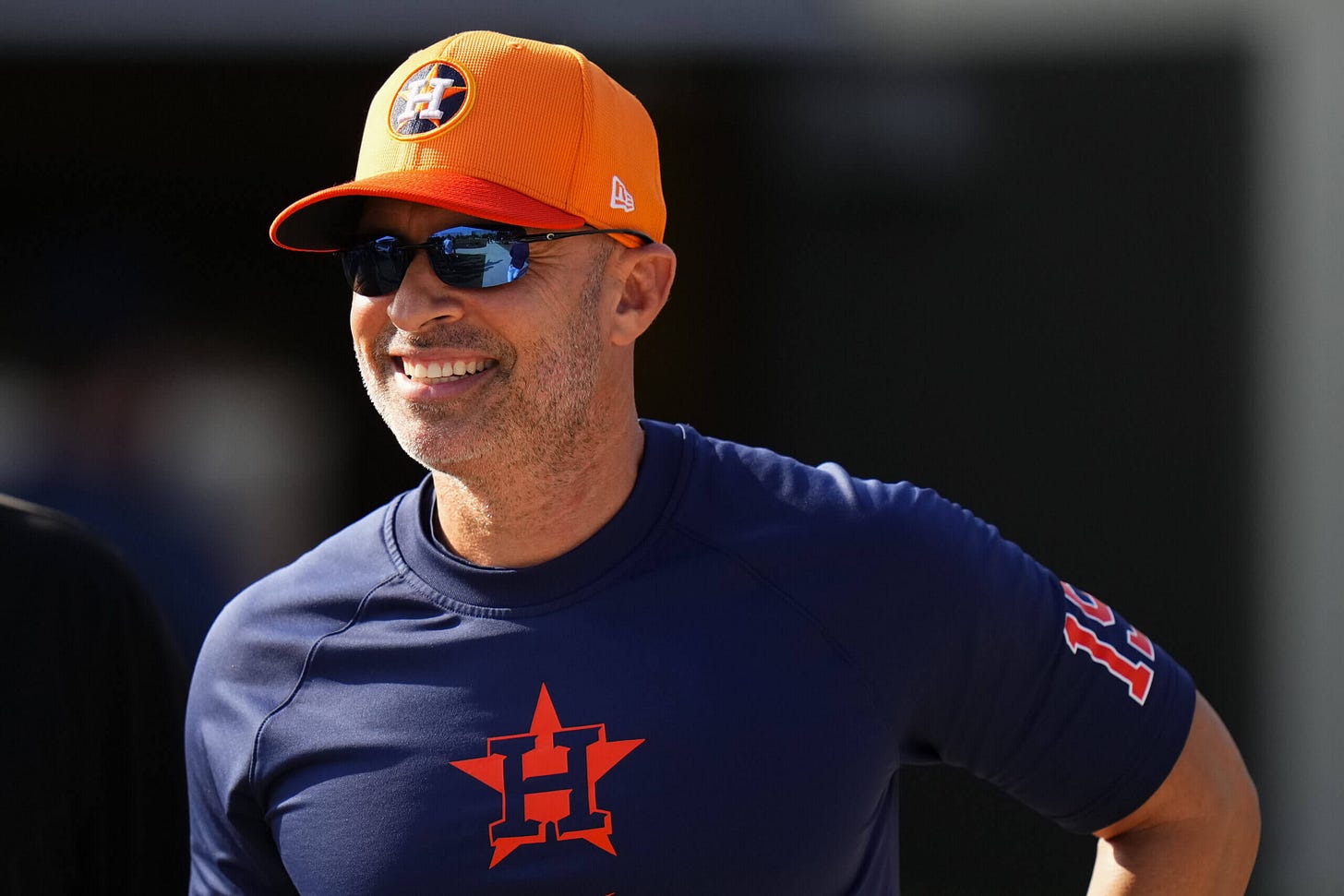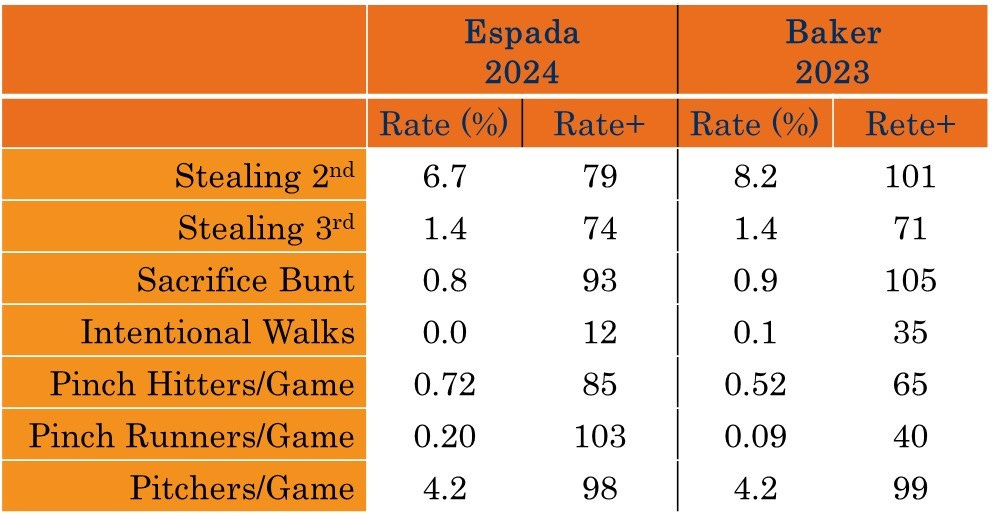How Much Has Joe Espada Changed Things As Astros Manager?
The Astros made a change in their manager, but in a way the emphasized continuity. I examine what has changed under Joe Espada, and what has remained the same.
The Astros made a big change last offseason. Dusty Baker retired after 26 seasons as a big league manager. The Astros turned Joe Espada—who had served as the team’s bench coach since 2018.
In writing about the Espada hire, I said it was “a hire about continuity.” The Astros made an internal hire in large part because Dana Brown and the rest of the team’s top brass thought things were going well in the clubhouse. But I also wrote at the beginning of Spring Training about the ways that “Espada’s managerial choices might be different” from Baker’s.
There is an obvious tension between those two sentences. Espada’s hire reflects continuity within the team, yet as a different person, he would likely do things different than the previous manager.
We now have nearly 150 games worth of evidence about Joe Espada as manager. Let’s see what’s changed and what has remained the same.
Valuing the 2 Spot in the Batting Order
In writing about what Espada might do differently than Baker, I noted that
He might value the #2 spot in the order similarly to most other MLB managers. Thanks to the shift to analytical thinking—and the face that batters at the top of the order get more plate appearances—managers have begun hitting their best hitters early in the lineup, regardless of how fast or slow they are…
If Espada follows this trend, he may bat Tucker 2nd instead of in the middle of the order. Heck, he may bat Yordan Alvarez—the Astros best hitter—in the 2 spot.”
In general, Espada has put his best hitters at the top of the order so that they can get the most plate appearances. This is similar to contemporary analytic thinking in baseball—roles in lineup order are overrated; just get your best hitters up.
Baker tended to side with more traditional thinking—your top two guys need to be a fast guy and your power hitters in the middle of order.
One can see that in Baker’s 2023 lineup choices. When his lineup was healthy and rested, he would hit his best hitters in the top 4 spots. But when they were out, he stuck to traditional roles. Mauricio Dubon hit leadoff in 61 games in 2023. Jeremy Pena hit leadoff 12 times and in the 2 spot on 44 occasions.
This season, Jose Altuve has been healthy most all of the season, so he’s hit leadoff in all but 7 games. But who hit leadoff in the other 7 games? Alex Bregman did 5 times and Kyle Tucker did twice.
Espada has hit Kyle Tucker earlier in the order more than Baker did. In addition to his 2 games in the leadoff spot, Tucker has hit 2nd 26 times, 3rd in 24 games, and cleanup in 13 starts. He’s never hit in the 5th spot this year, unlike in 2023 where he hit there on 56 occasions. Baker never put Tucker in the 1 or 2 spot in the order last year.
Espada’s preference to load up his best hitters at the top of the order can be seen in how he uses the 3rd spot in the order. Yordan Alvarez has hit 3rd in 93 games this season. He’s never hit cleanup.
Espada has only put 4 different hitters in the 3 spot this year—but they are among his top hitters. As mentioned, Alvarez had made 93 starts there; Tucker 24; Yainer Diaz 22, and Alex Bregman 8.
That’s a contrast to the cleanup spot, which Espada has valued less than the 3 spot. As a result, Jake Meyers has hit cleanup 3 times, Jon Singleton twice, and Victor Caratini once.
Caratini hit cleanup on August 30, the first game of the Royals series. That’s when Alex Bregman was out with an elbow injury and Tucker had yet to return from the IL. Espada stacked his top hitters—Altuve as DH, Yordan in LF, Yainer at C—in the top three spots in the order.

More Urgency Via More Moves
When we play manager in our head (or on the tabletop or computer), we think about what moves to make that will vault our team to victory. When to throw in a pinch runner to steal a base, or when to put in a pinch hitter to get a clutch hit and drive in a run.
In 2023, there was criticism of Dusty Baker for doing little of this. For not making moves to press a particular platoon advantage. Friend of the Substack Mike Mitchell was one of the critics, asking Baker show more “urgency” in the wake of the close AL West race.
Joe Espada has made more of these type of moves in 2024, particularly in pinch hitting—sometimes as early as the 6th inning—to get a platoon advantage for one of his bottom of the order hitters. But has it been a lot more?
The chart below shows the answer. Baseball Reference records the number of “moves” made by each manager, the rate at which they make those moves, and then compares that rate to league average. In the chart below, I take the Rate and Rate+ numbers for Espada in 2024 and Baker in 2023.
In some ways, it is a story of continuity. Neither Espada nor Baker intentionally try to make outs via the sacrifice bunt much, though that is now the common strategy in the majors. Both eschew the intentional walk.
But it is also a story of change, especially in Espada’s willingness to use pinch hitters at a much higher rate than Baker did in 2023. Obviously, these decisions are not made in a vacuum. Who the players are matters in what type of decisions are made. One could argue—and many did—that Baker needed to pinch hit more in 2023 than the average manager because his everyday lineup included Martin Maldonado—who are a sub-replacement level hitter.
I’ll let Mitchell have the last word on this one, citing his Twitter post from late June.
A Relatively Slow Hook
In writing about Espada in February, I said that “If Espada is a more average manager this season, the Astros will get shorter outings from their starters and more innings from relievers.”
This prediction really hasn’t come true. At some level it has, the Astros are 7th in innings per start, after finishing 2nd under Baker in 2023. The Astros got 5.55 innings per start in 2023; it’s down to 5.44 innings per start this season.
But much of that decline seems to have come from a decline in performance from the starters, especially early in the season. Unsurprisingly, the best rotations have pitched the most inning, as their managers are less likely to think they need to call on a reliever to get an out and because they get more outs per pitch.
The Mariners lead the majors in both ERA from starters and innings pitched. The Royals are second in both categories. That connection is not surprising.
But the Astros are 11th in ERA, lower than their ranking in innings per start. They are actually 5th in the number of pitches thrown by starters.
The combination of lots of pitches and a higher ERA is not necessarily good. Astros starting pitchers are actually 21st in the majors in pitches per out. It takes Astros pitchers on average 5.53 pitches to get an out, just ahead of the Angels, who of course, do not have very good rotation. It take Seattle starters only 5.10 pitches to get an out.
The reason I put all that data together is to show that Joe Espada has a relatively slow hook. He is more likely to stick with his starting pitcher than a contemporary big league manager. And in that choice, he looks a lot like Dusty Baker did in his time as Astros manager.
The Clubhouse Seems Fine, Though It’s Hard To Tell
I have identified some of the visible choices that Joe Espada has made as manager. These are the ones we can identify and quantify.
In February, I wrote that “the job of a major league manager is about managing men, much more than it is about lineup decisions and bullpen moves…The biggest difference between Baker and Espada will be how they handle the men in their clubhouse.”
How has Espada done at managing the men who are on his big league roster? At one level, we do not really know. We are not in the clubhouse to know and can only infer from other data.
At one level, Espada must be doing well in this regard because the Astros went from a team having a disastrous opening month of the season to one of the best records in baseball since then.
Did Espada cause the turnaround? Probably not, but it’s not like he kept it from happening. Espada did call a team meeting as the team boarded its flight from Chicago to Mexico City after hitting its nadir at 7-19.
“I wanted just to put that series in Chicago behind us and use Mexico as a starting point, reset button,” Espada said at the time. “It was more put things behind us; we need to do X, Y and Z better. Let’s do those things, and if we do that, we’ll be fine.”
Did the team meeting turn the season around? Probably not. Teams do this all the time with only modest success. That probably turned the Astros season around is that the team started playing to its capabilities, which it clearly was not doing during the 7-19 start.
What we can say is that we have heard little indication that things are going poorly in the clubhouse. There have been almost no odd clubhouse controversies that the bubbled up to the public. Things for the most part seem to be smooth sailing in the clubhouse.
We did get a report from Bob Nightengale in early May that “two prominent players have privately expressed complaints about Espada’s communication skills in recent weeks.”
It’s hard to know what to do with that Nightengale story—how “read” was the issue; who actually leaked to Nightengale (I doubt it was the players); and for what reason.
But it was not followed up with other reports of clubhouse discontent. It seems likely the complaints centered on the early losing skid, and the clubhouse got better because the team started winning more.
This is pretty normal behavior. Opinions on a manager’s performance are highly contingent on whether or not the team is playing well. They are not necessarily connected to how well the manager is doing his job. That’s true for not just us fans, but also players themselves.
What I have tried to do here is focus on what Joe Espada has actually done in his job as the manager of the Astros. There are some clear areas of continuity from the decision making we saw with Dusty Baker—especially when it comes to his faith in his starting pitchers. There are other areas of change—valuing the early spots in the order more and using more pinch hitters.
The thing that has not changed from 2023. The Astros are good team and going to win the division—once again. Changing managers didn’t change that.





